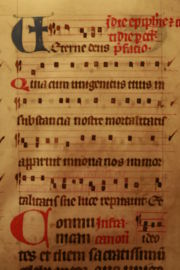
Accentus Ecclesiasticus
Encyclopedia

Church music
Church music may be defined as music written for performance in church, or any musical setting of ecclestiacal liturgy, or music set to words expressing propositions of a sacred nature, such as a hymn. This article covers music in the Judaeo-Christian tradition. For sacred music outside this...
term, the counterpart of concentus, indicating those parts sung solo by a clergyman. The terms accentus and concentus were probably introduced by Andreas Ornithoparchus in his Musicae Activae Micrologus, Leipzig, 1517.
In the medieval church, all that portion of the liturgical song which was performed by the entire choir
Choir
A choir, chorale or chorus is a musical ensemble of singers. Choral music, in turn, is the music written specifically for such an ensemble to perform.A body of singers who perform together as a group is called a choir or chorus...
, or by sections of it, was called concentus; thus hymn
Hymn
A hymn is a type of song, usually religious, specifically written for the purpose of praise, adoration or prayer, and typically addressed to a deity or deities, or to a prominent figure or personification...
s, psalms, mass ordinary, and alleluia
Alleluia
The word "Alleluia" or "Hallelujah" , which at its most literal means "Praise Yah", is used in different ways in Christian liturgies....
s were, generally speaking, included under this term, as well as anything with more complex or distinctive melodic contours. On the other hand, such parts of the liturgy which the priest
Priest
A priest is a person authorized to perform the sacred rites of a religion, especially as a mediatory agent between humans and deities. They also have the authority or power to administer religious rites; in particular, rites of sacrifice to, and propitiation of, a deity or deities...
, the deacon
Deacon
Deacon is a ministry in the Christian Church that is generally associated with service of some kind, but which varies among theological and denominational traditions...
, the subdeacon
Subdeacon
-Subdeacons in the Orthodox Church:A subdeacon or hypodeacon is the highest of the minor orders of clergy in the Orthodox Church. This order is higher than the reader and lower than the deacon.-Canonical Discipline:...
, or the acolyte
Acolyte
In many Christian denominations, an acolyte is anyone who performs ceremonial duties such as lighting altar candles. In other Christian Churches, the term is more specifically used for one who wishes to attain clergyhood.-Etymology:...
sang alone were called accentus; such were the collect
Collect
In Christian liturgy, a collect is both a liturgical action and a short, general prayer. In the Middle Ages, the prayer was referred to in Latin as collectio, but in the more ancient sources, as oratio. In English, and in this usage, "collect" is pronounced with the stress on the first syllable...
s, the epistle
Epistle
An epistle is a writing directed or sent to a person or group of people, usually an elegant and formal didactic letter. The epistle genre of letter-writing was common in ancient Egypt as part of the scribal-school writing curriculum. The letters in the New Testament from Apostles to Christians...
and gospel
Gospel
A gospel is an account, often written, that describes the life of Jesus of Nazareth. In a more general sense the term "gospel" may refer to the good news message of the New Testament. It is primarily used in reference to the four canonical gospels of Matthew, Mark, Luke, and John...
, the preface
Preface (liturgy)
In liturgical use the term Preface is applied to that portion of the Eucharistic Prayer that immediately precedes the Canon or central portion of the Eucharist...
, or anything which was recited chiefly on one tone, rather than sung, by the priest or one of his assistants. The accentus should never be accompanied by harmonies, whether of voices or of instruments, although the concentus may receive such accompaniment. The intoning words Gloria in excelsis Deo and Credo in Unum Deum, being assigned to the celebrant alone, should not be repeated by the choir or accompanied by the organ
Pipe organ
The pipe organ is a musical instrument that produces sound by driving pressurized air through pipes selected via a keyboard. Because each organ pipe produces a single pitch, the pipes are provided in sets called ranks, each of which has a common timbre and volume throughout the keyboard compass...
or other musical instrument
Musical instrument
A musical instrument is a device created or adapted for the purpose of making musical sounds. In principle, any object that produces sound can serve as a musical instrument—it is through purpose that the object becomes a musical instrument. The history of musical instruments dates back to the...
.
There were originally seven types of Accentus Ecclesiasticus, depending on how the voice should be inflected at the punctuation marks ending phrases or sentences. In accentus immutabilis, the voice remains at the same tone; in accentus medus it falls by a third at a colon; in accentus gravis it falls by a fifth at a period; in accentus actus it falls by a third and returns to the original tone at a comma; in accentus moderatus it rises by a second and returns to the original tone at a comma; in accentus interrogata it falls by a second and returns to the original tone at a question mark; and in accentus finalis, it rises by a second and then falls stepwise to a fourth below the original tone at the end.

